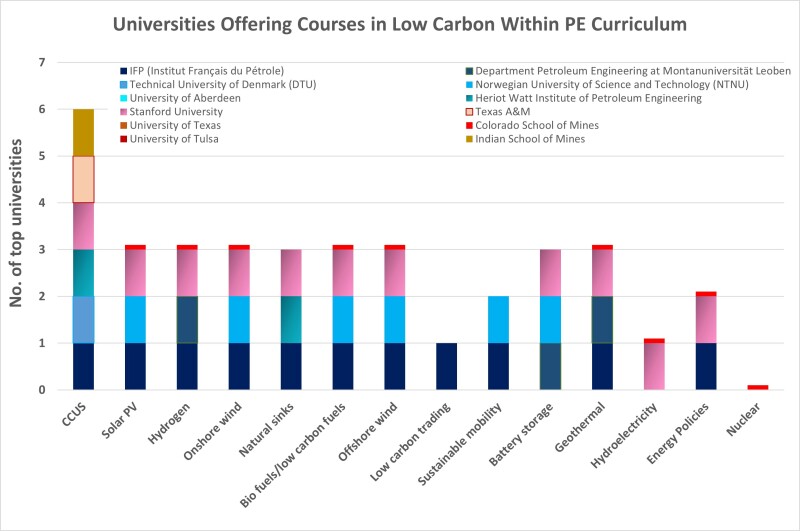The first article of the series laid out the three critical pillars of a successful energy transition: People, business processes, and regulatory infrastructure. Their availability (or lack thereof) will determine how rapid the energy transition is going to be.
This article, the second in the series, focuses on the people aspect of the energy transition, particularly on the approach taken by companies and universities to upskill employees and students to create the “workforce of the future” that will help deliver this transition.
People: A Key Resource To Make All This Happen
The industry needs a wider variety of skillsets as it broadens its investments in low-carbon businesses. Along with the conventional oil and gas roles, we are already seeing new types of jobs such as Decarbonizing Advisor, Energy Transition Advisor, and New Fuels Manager. So how is the industry planning to fill the human resource funnel if students see ours as a dying industry? What are the universities doing to revise their curricula? What new options are there for students interested in the energy field?
First, we need to break down the skills requirements into technical and non-technical skills.
Non-technical skills, such as legal, finance, supply chain, and business development are generalist in nature and transferable across different businesses, whether oil and gas or new energies. Some of the major oil and gas companies are focusing to redirect existing staff to new energies business units with these transferable skills. However, there is a delicate balance between starving cash-generating assets vs. investing that talent in future engines of growth.
“The need of the hour is a ‘T-shaped engineer,’ a generalist who is readily deployable across a broad range of roles in oil and gas as well as new energies,” says GM for capital projects supply chain in a major oil and gas company. In addition to providing this transferability, this is important for employees as well given the reduced career longevity in the industry over the last couple of decades. More companies go through reorganization more often, and hence professionals with more generalist skills are better placed to adapt to changing business needs.
Nevertheless, the conventional technical oil and gas roles are not going away. “These roles will continue to exist, and may become niche going forward,” said Mohan Kelkar, chairman and professor of petroleum engineering at University of Tulsa. They will evolve as the companies continue to operate oil and gas assets with an increased emphasis on lowering their carbon footprints; more companies are adding greenhouse gas emissions as a critical evaluation metric for making final investment decisions on their projects.
However, there seems to be skills gap for technical jobs in new energies. Companies are generally finding it difficult to get the skills needed in this area. It is a little easier in a more closely related business, such as Oxy’s carbon capture, utilization, and storage (CCUS) project, where the company is utilizing its core enhanced oil recovery skills for carbon management in newer areas such as sequestration.
The technical talent supply funnel from academia is underdeveloped, and the few talent resources in the industry are being poached, either as direct hires, contractors, or outright buy-outs of companies holding that talent. To upskill employees and keep them relevant, companies are encouraging them to go through rotation assignments in their low-carbon/new energy ventures so that skills are transferred to other businesses and operations. Doug Conquest, VP of low carbon ventures at Oxy, advises “those currently working and studying in subsurface disciplines to take every opportunity to expand their knowledge base to include [CO2] sequestration, and not limit it to conventional oil and gas applications.”
National oil companies have taken a different approach in the energy transition by investing heavily in their in-house R&D initiatives. Some companies are investing in collaborative research work with universities, but those are still in nascent stages.
Essentially the skills gap has widened in our industry. The dynamism of the energy transition requires a larger variety of skills, with a focus on those that can be readily deployed across a variety of businesses with minimal to no re-skilling. The challenge is for universities to accommodate this, but such changes take time.
Academia and Students
Given the poor perception of our industry and the perceived uncertainty about its future, universities are seeing a drop in the number of applicants in core petroleum programs (Fig. 1). In addition, oil and gas companies are now forced to compete with other sectors such as the tech industry for bright new hires. This raises the following pertinent questions:
- How do universities continue to maintain the pipeline of talent for the energy industry today and in the future?
- How will universities continue to attract top talent to their energy programs?

Although adapting to the educational needs of the energy transition has generally been slow in US universities, some such as the Energy Resources Engineering (ERE) department of Stanford University have retooled their curriculum. “The ERE department curriculum [now] focuses on [carbon] storage, batteries, life cycle analyses, and optimization of renewable energy systems, techno-economic analyses, and policy,” said Tapan Mukerji, research professor at Stanford University. Other US university petroleum departments are making organic modifications to the conventional petroleum engineering courses. Kelkar mentioned the introduction of four minor courses designed for carbon management and sustainable energy in the petroleum engineering curriculum at University of Tulsa.

Figure 2 shows the new energy courses offered by top petroleum schools of the world, which is congruent with the industry’s investment trend and academia’s focus on CCUS. However, there is a clear disconnect in the US-based petroleum schools. According to Kelkar, “This gap is driven by the lack of funding from companies.” While we have seen a lot of strategic promises by the oil and gas companies, Kelkar has seen no noticeable change in US companies’ hiring strategy or research funding for academia yet. This differs from their European counterparts, who seem to be further ahead in this journey with more active corporate and government support.
Another aspect of this slow adaptation in the US is the perceived lack of support from the Accreditation Board of Engineering and Technology (ABET), the leading authority for validating university degrees and programs. ABET does not currently have programs focusing on new energies. University programs risk losing their accreditation if they replace conventional courses with those that specialize in this domain. “And the large number of credit hours required for petroleum engineering majors in the US prevents universities from adding new courses to their existing programs,” says Lloyd Heinze, professor, Texas Tech University, who also serves as the SPE representative on the ABET board of delegates.
In summary, to take the next step in the energy transition, concerted efforts are needed in developing the workforce of the future. This requires the industry, universities, and ABET to work together, as no one stakeholder can do it independently. Government and oil and gas company funding is needed for new energies R&D programs at the universities. Relevant courses in fields such as solar, wind, geothermal, and CCUS need to be added to the current engineering curricula. The industry also needs to collaborate with universities in developing the courses and research programs that will equip graduates with the skills needed for the energy transition. A clear direction from the companies can help universities to adapt quickly to the changing needs. Young professionals need to be open to these broader courses that will look very different from the traditional petroleum engineering classes. Bear in mind that many types of energies—including oil and gas—will have a commercial role to play for decades to come.
Be on the lookout for our next articles on Business Processes and Regulatory Framework in this series to continue this conversation.

